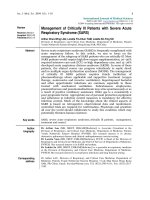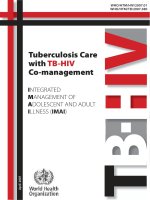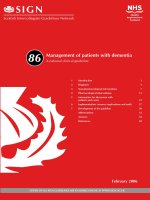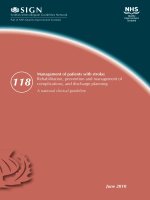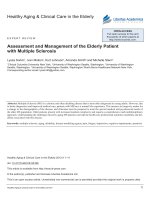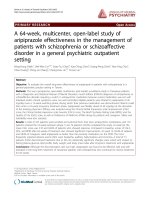Management of neonates with suspected or proven early onset
Bạn đang xem bản rút gọn của tài liệu. Xem và tải ngay bản đầy đủ của tài liệu tại đây (423.05 KB, 24 trang )
Management of Neonates With Suspected
or Proven Early-Onset Bacterial Sepsis
Richard A. Polin and the COMMITTEE ON FETUS AND NEWBORN
Pediatrics 2012;129;1006; originally published online April 30, 2012
Content
•
Abstract
•
Pathogenesis and Epidemiology
•
Diagnostic testing
•
Treatment of infants with suspected early-onset
•
Prevention strategies for early-onset sepsis
•
Clinical challenges
•
Conclusions
Abstract
•
Early-onset sepsis remains one of the most common causes of neonatal
morbidity and mortality in the preterm population.
•
Diagnostic tests for neonatal sepsis have a poor positive predictive
accuracy
•
Recent data suggest an association between prolonged empirical
treatment of preterm infants (≥5 days) with broad-spectrum antibiotics
and higher risks of late onset sepsis, necrotizing enterocolitis, and
mortality
•
The purpose of this clinical report is to provide apractical and, when
possible, evidence-based approach to the managementof infants with
suspected or proven early- onset sepsis
What are challenges for clinicians?
•
Identifying neonates with a high likelihood of sepsispromptly and initiating
antimicrobial therapy
•
Distinguishing “highrisk” healthy-appearing infants or infants with clinical
signs who do not require treatment
•
Discontinuing antimicrobial therapy once sepsis is deemed unlikely
Pathogenesis and Epidemiology
•
Chorioamnionitis is a major risk factor for neonatal sepsis
•
Diagnosis: based on maternal fever >38°C and at least two of the
following criteria:
maternal leukocytosis (>15 000 cells/mm3)
maternal tachycardia (>100 beats/minute)
fetal tachycardia (>160 beats/minute)
uterine tenderness
and/or foul odor of the amniotic fluid
Pathogenesis and Epidemiology
•
The major risk factors for chorioamnionitis:
low parity
spontaneous labor
longer length of labor and membrane rupture
multiple digital vaginal examinations (especially with ruptured
membranes)
meconium-stained amniotic fluid
internal fetal or uterine monitoring
and presence of genital tract microorganisms
Pathogenesis and Epidemiology
•
The rate of microbial invasion of the amniotic cavity:
Term gestation, intact membranes: <1%
Preterm labor, intact membranes: 32%
PPROM: 75%
•
Preterm birth/low birth weight is the risk factor most closely associated
with early-onset sepsis
•
Many of the pathogens recovered from amniotic fluid in women with
preterm labor or PPROM (eg, Ureaplasma species or Mycoplasma
species) do not cause early-onset sepsis.
•
However, both Ureaplasma and Mycoplasma organisms can be
recovered from the bloodstream of infants whose birth weight is <1500 g
Diagnostic testing
Blood Culture:
Require for all neonates with suspected sepsis
1.0 mL of blood should be the minimum volume drawn
A study by Connell et al indicated that blood cultures with an
adequate volume were twice as likely to yield a positive result
A blood culture through an umbilical artery catheter is an acceptable
alternative to a culture drawn from a peripheral vein
Diagnostic testing
• Lumbar Puncture
In bacteremic infants, the incidence of meningitis may be as high as
23%
Blood cultures can be negative in up to 38% of infants with meningitis
• The lumbar puncture should be performed in infants with:
positive blood culture
clinical course or laboratory data strongly suggest bacterial sepsis
worsen with antimicrobial therapy
Diagnostic testing
Cerebrospinal fluid (CSF)
In a study by Garges et al, the median number of white blood cells in
infants who had bacterial meningitis: >34 weeks’ gestation was
477/mm3 , <34 weeks’ gestation was 110/mm3
Infants with meningitis attributable to Gram-negative pathogens
typically have higher CSF white blood cell counts than do infants with
meningitis attributable to Grampositive pathogens
Protein concentrations are higher and glucose concentrations are
lower in term than in preterm infants with meningitis
Diagnostic testing
Peripheral White Blood Cell Count and Differential
Count
Total white blood cell counts have little value in the diagnosis of
early-onset sepsis and have a poor positive predictive accuracy
Neutrophil indices have proven most useful for excluding infants
without infection rather than identifying infected neonates
Neutropenia may be a better marker and has better specificity
than an elevated neutrophil count
In late preterm and term infants, the definition for neutropenia most
commonly used is that suggested by Manroe et al (<1800/mm3 at
birth and <7800/mm3 at 12–14 hours of age)
Diagnostic testing
• Schmutz et al reinvestigated in 30 254 infants born at 23 to 42 weeks’ gestation
• Peak values occurred at 6 to 8 hours after birth
• The lower limits of normal for neutrophil values:
At birth (/mm3)
6-8h after birth
(/mm3)
> 36 weeks
3500
7500
28 – 36 weeks
1000
3500
< 28 weeks
500
1500
• The I/T ratio has the best sensitivity of any of the neutrophil indices
• The I/T ratio is <0.22 in 96% of healthy preterm infants born at <32 weeks’ gestational age
• A single determination of the I/T ratio has a poor positive predictive accuracy
(approximately 25%) but a very high negative predictive accuracy (99%)
Diagnostic testing
Acute-Phase Reactants
CRP increases within 6 to 8 hours of an infectious episode in
neonates and peaks at 24 hours
The sensitivity is low at birth
Benitz et al have demonstrated that excluding a value at birth, 2
normal CRP determinations (8–24 hours after birth and 24 hours
later) have a negative predictive accuracy of 99.7% and a negative
likelihood ratio of 0.15 for proven neonatal sepsis
If CRP determinations remain persistently normal, it is strong
evidence that bacterial sepsis is unlikely, and antimicrobial agents
can be safely discontinued
Diagnostic testing
Procalcitonin increase within 2 hours of an infectious episode, peak
at 12 hours, and normalize within 2 to 3 days in healthy adult
volunteers
A physiologic increase in procalcitonin occurs within the first 24 hours
of birth, and an increase in serum can occur with noninfectious
conditions (eg, respiratory distress syndrome)
Procalcitonin has a modestly better sensitivity than does CRP but is
less specific
Treatment of infants with suspected early-onset
•
A combination of ampicillin and an aminoglycoside (usually gentamicin)
is generally used as initial therapy, and this combination of antimicrobial
agents also has synergistic activity against GBS and Listeria
monocytogenes
•
Third-generation cephalosporins (eg, cefotaxime) represent a reasonable
alternative to an aminoglycoside
•
Several studies have reported rapid development of resistance
cefotaxime, and prolonged use of third-generation cephalosporins risk
factor for invasive candidiasis
Treatment of infants with suspected early-onset
•
Bacteremia without an identifiable focus of infection is generally treated
for 10 days
•
Gramnegative meningitis is treated for minimum of 21 days or 14 days
after obtaining a negative culture
•
Uncomplicated meningitis attributable to GBS is treated for a minimum
of 14 days
•
In a retrospective study by Cordero and Ayers, the average duration of
treatment in 695 infants (<1000 g) with negative blood cultures was 5 ±
3 days
•
Cotten et al have suggested an association with prolonged
administration of antimicrobial agents (>5 days) in infants with suspected
early-onset sepsis (and negative blood cultures) with death and
necrotizing enterocolitis
Prevention strategies for early-onset sepsis
•
The only intervention is maternal treatment with intrapartum intravenous
antimicrobial agents for the prevention of GBS infections
•
Penicillin (the preferred agent), ampicillin, or cefazolin given for ≥4 hours
before delivery
•
Intrapartum antimicrobial agents are indicated for the following situations:
Positive antenatal cultures or molecular test at admission for GBS
(except for women who have a cesarean delivery without labor or
membrane rupture)
Unknown maternal colonization status with gestation <37 weeks,
rupture of membranes >18 hours, or >38°C
GBS bacteriuria during the current pregnancy
Previous infant with invasive GBS disease
Clinical challenges
Challenge 1: Identifying Neonates With Clinical Signs of Sepsis With
a “High Likelihood” of Early-Onset Sepsis Who Requir Antimicrobial Agents
Soon After Birth
•
Most infants with early-onset sepsis exhibit abnormal signs in the first 24
hours of life
•
Approximately 1% of infants will appear healthy at birth and then
develop signs of infection after a variable time period
•
Every critically ill infant should be evaluated and receive empirical
broad-spectrum antimicrobial therapy after cultures, even when there
are no obvious risk factors for sepsis.
Clinical challenges
Challenge 2: Identifying Healthy-Appearing Neonates With a “High
Likelihood” of Early-Onset Sepsis Who Require Antimicrobial Agents Soon
After Birth
•
The greatest risk of early-onset sepsis occurs in infants born to women
with chorioamnionitis who are also colonized with GBS and did not
receive intrapartum antimicrobial agents.
•
Early-onset sepsis does occur in infants who appear healthy at birth
Infants <37 weeks’ gestation
Infants ≥37 weeks’ gestation
Infants ≥37 weeks’ gestation
Conclusions
•
Neonatal sepsis is a major cause of morbidity and mortality
•
Diagnostic tests for early-onset sepsis (other than blood or CSF cultures)
are useful for identifying infants with a low probability of sepsis but not at
identifying infants likely to be infected.
•
One milliliter of blood drawn before initiating antimicrobial therapy
•
Lumbar puncture is not needed in all infants with suspected sepsis
•
The optimal treatment of infants with suspected early-onset sepsis is
broad-spectrum antimicrobial agents
•
Antimicrobial therapy should be discontinued at 48 hours in clinical
situations in which the probability of sepsis is low.
Thank you for
your attention
